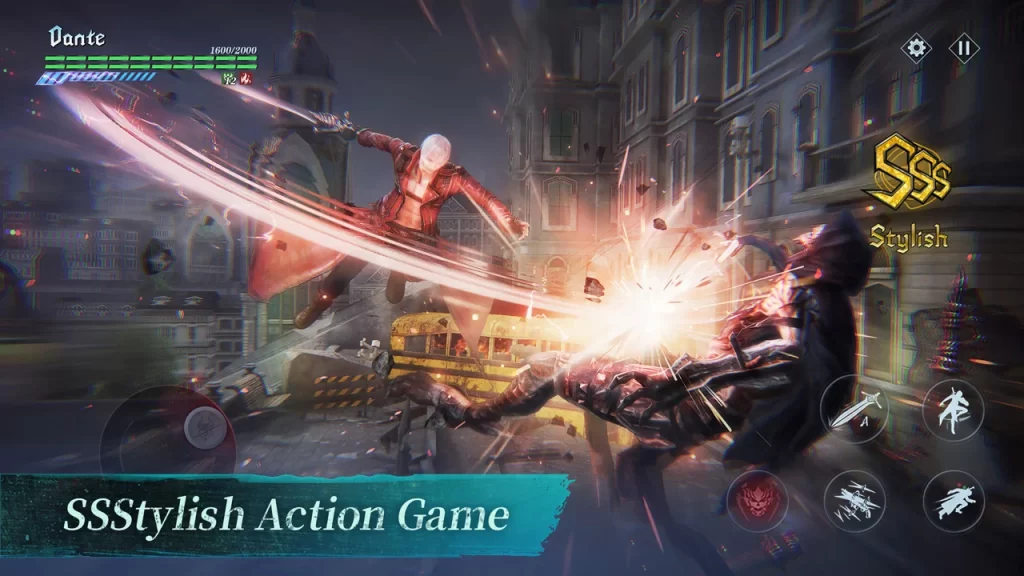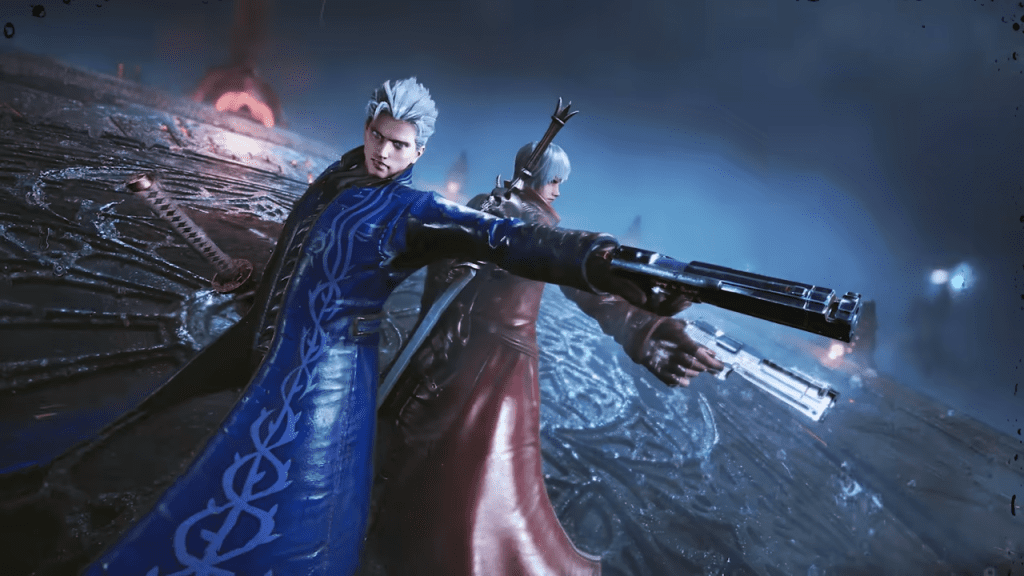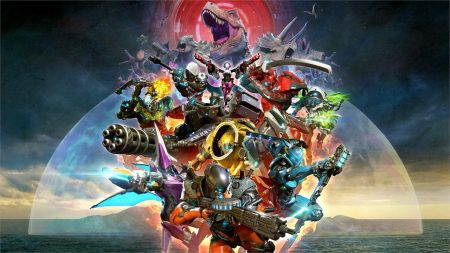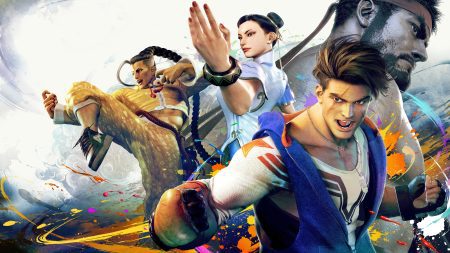As a self-proclaimed Devil May Cry aficionado, I threw on my red trench coat, grabbed a slice of pizza, and got ready to unleash hell when Devil May Cry: Peak of Combat was announced for iOS and Android. Then, I played it—and, turns out, I wasn’t ready for the cash grab Capcom had in store.
NebulaJoy—the independent team contracted to develop the game—does a commendable effort to bring the adrenaline-fueled gameplay of Devil May Cry to the small screen. The series’ flashy jump cancels and combo styles have been faithfully recreated for phones and tablets, making for visually entertaining combat. Unfortunately, lurking beneath this stylish surface lies the sinister specter of gacha game mechanics.
Gacha Ghouls
Devil May Cry: Peak of Combat tries to fool you with the usual ballet of blades and bullets, but there’s an immediate catch. The game essentially recycles, chops up, and remixes the DMC movements from the mainline console games, but never gives you the complete experience. The DMC universe is filled with cool weapon aesthetics, stylish clothes, and special moves. In this game, though, Dante can’t even shoot his trademark guns, Ebony and Ivory, outside of cutscenes.
Peak of Combat features the typical series stalwarts, including Dante, Lady, Nero, and Vergil. Each character has their own weapons, move-sets, and special moves. Unfortunately, there is no way to directly purchase the character you wish to play as. You can purchase the possibility, though, with low-probability gacha rolls. Even when you do unlock a character you want, their movements consist of stripped-down move sets, which you’re forced to upgrade through more in-game (and paid) currency. It’s a move that feels less like a calculated creative risk and more like a cynical cash grab, detracting from the charm of the core gameplay.

Peak of CapitaliSSSm
The departures from the previous games are glaring. There’s no style switching; instead, you and two other shells of DMC characters shamble into an arena, each with one weapon, one style, and, often, one combo.
The three-person team structure adds a unique Marvel Vs Capcom tag-in mechanic that allows you to execute powerful special moves. In any other DMC title, however, you’d be able to do these flashy moves at your leisure. Thankfully, the game also includes a special counter—executed by jumping right when an enemy attacks you—which hits satisfyingly hard.
Peak of Combat introduces two additional (questionable) firsts for the series in the form of cooldowns for special moves and elemental attacks/weaknesses for enemies. These are stark departures from the series’ traditional mechanics, altering the strategic landscape significantly. While I’m sure the developers aimed to enhance the gameplay depth, these mechanics often contribute to a sense of frustration and imbalance.
I won’t lie, though: Juggling enemies, jump canceling, and swapping characters mid-combo gave the occasionally effective illusion that I was playing a real DMC game. Then, the torment of cooldowns, elemental combat, currency grinding, and other tedious gatcha mechanics jerked me back to reality.
Make no mistake: This is Devil May Cry: Peak of Capitalism—the intrusive, confusing, pay-to-play style of video game capitalism we’re all too accustomed to.
Not-So-Smokin’ Sexy
As I journeyed through Peak of Combat, I found myself hitting a wall around Chapter 8, where the game’s difficulty spiked dramatically. It’s here that the insidious grip of monetization tightens its hold, tempting players to fork over real cash for stronger weapons and characters. This pay-to-win approach clashes with the series’ tradition of skill-based challenges, leaving a bitter taste in my mouth. I almost quit there, but I pushed on like a true devil hunter impaled by his sword.
That is, until I made it to Chapter 10, where I just couldn’t take it anymore. The difficulty spikes in each level demanded meticulous management of weapons, crystals, gems, cards, and other items, shifting the focus from skill to item management and straight-up gambling. The same enemy I’d killed 100 times before suddenly became an invincible menace.
The highest level I managed to get one of my characters to was 13. I don’t know how high the level cap goes, but it’s not high enough for the next encounter. Even if you try to “get gud,” there’s still a timer for each encounter, and the enemies will easily wait you out. But I can’t afford to buy the things that would make it easier for me to advance the game any further. The paltry offerings the game throws at you for completing various missions aren’t nearly enough. However, one could argue that the inclusion of gacha mechanics is a thematic nod to Dante’s canonical debt and penchant for gambling.

Bury This Game
Peak of Combat’s aesthetic and design pays homage to its predecessors, weaving together elements from previous Devil May Cry titles. Even Dante’s love for pizza serves as a mechanic—in this case, a resource that limits the amount of in-game activities you can complete in a real-life day. Typical.
The story itself feels like a missed opportunity, often losing me in its convoluted narrative of time travel hijinks. From what I was able to make of it, Dante encounters some crazy time artifact and chaos ensues. The absence of the mainline games’ voice actors (even the more problematic ones) only further disconnected me from the experience, though the new cast does its best to salvage the occasionally awkward dialogue.
Devil May Cry: Peak of Combat introduces a small rotation of enemies from different parts of DMC lore, adding a layer of nostalgia to the gameplay experience. However, the repetitive nature of these enemies, coupled with the game’s altered strategy, diminishes the excitement of encountering new adversaries.
The Devil’s in the Details
This ghoulish game’s one saving grace is its alternate modes. With the other Devil May Cry games, there weren’t many modes to play unless you wanted to beat the main campaign with an SSS rank on every mission and difficulty level. You also had the Bloody Palance in more recent entries, but replayability simply hasn’t been the series’ strong suit.
Peak of Combat introduces new characters in timed special events that offer temporary additional story modes, side missions, rewards, and resources to collect. You can play through the character’s tutorials during these events, or you can access them at a later time. However, the stories don’t amount to much—a few seconds of the character grabbing a time travel device and seeing fleeting visions of the future, then you’re off to the next battle arena. When you take a break from the story mode, you can take on bounty-like “requests.” Complete these optional side missions—typically a rotating set of enemies or a boss fight—and you’ll receive some in-game rewards.
Additional modes—such as Perfect Timing, Vine of Greed, Airborne Challenge, and Skyfall Well—turn special missions into challenges you can participate in once per day. Realm Conqueror feels like a Bloody Palace mode similar to DMC 3’s. The Slot of Slaughter, which gives your characters stat bonuses, is a randomized mode that lets you either hit the jackpot or fight a group of enemies with randomized buffs, nerfs, and restrictions. It’s fun, but it costs pizza to play.
The modes that drew me in most were those that have long been requested for the mainline series. Although DMC 5 lets (occasionally) play a pseudo co-op mode with other online players, Peak of Combat offers a true multiplayer co-op experience where you can face various challenges or hunt bosses with 99 health bars with a group of strangers.
Sky Arena also emerges as an intriguing concept, offering one-on-one battles in a dynamic arena setting. While the idea holds promise, it currently lacks the polish and refinement needed to fully captivate players, especially with each character’s limited move-set. With further development and iteration, Sky Arena could evolve into a standout feature, enhancing the overall experience for players seeking competitive gameplay. It’d be great to see some implementation of these modes in future DMC titles.

Final Thoughts
Devil May Cry: Peak of Combat is an ambitious stumble into mobile gaming for the franchise—one that delivers a mixed bag of thrills and gatcha-based frustrations. While it successfully captures the essence of the Devil May Cry series, its departure from traditional mechanics and reliance on unfair difficulty spikes and time limits detract from the overall experience.
This is a game for DMC newcomers, as well as people like me who are desperate for new content. Unfortunately, without adjustments to its design and a renewed focus on balance, Peak of Combat won’t hit the jackpot anytime soon.
Score: 4.0/10
Donovan is a lifelong gamer with a love for fast-paced, single-player action games—especially Devil May Cry, Metroidvanias, indies, and action RPGs. He’s also an “advanced scrub” at fighting games and will play just about anything fun. Donovan is passionate about seeing more diverse characters and creators in the industry—or at least better hair options for Black people. With over a decade in journalism, he joined The Punished Backlog in 2023 to write more about what he loves. Follow him on Twitter and Instagram @dono_harrell.










2 Comments
Well you said it right. The game is dying now. It’s been only 7 months since the game officially launched globally. There’s no replayed story. No new content. They keeping adding more characters in hope of getting more money out of the people pockets. The game is becoming almost unplayable with the bugs. No updates for months now. There are barely any ppl in co-op mode. The amount of gems they give is pathetic. Dmc peak of greed.
Not gonna lie to you, it’s a mobile game. What did you expect. Honestly it’s not that bad. There’s a stark difference between mobile games and console games and I think it’s definitely on the higher side for a mobile game. I’ve been disappointed time and time again with the same rpg game formating and this game was a sip of fresh air. Also the gacha is always going to be unfair, it’s a gacha. If it scared you so much you should of deleted the game right when you saw it. The game is grindy for sure though.